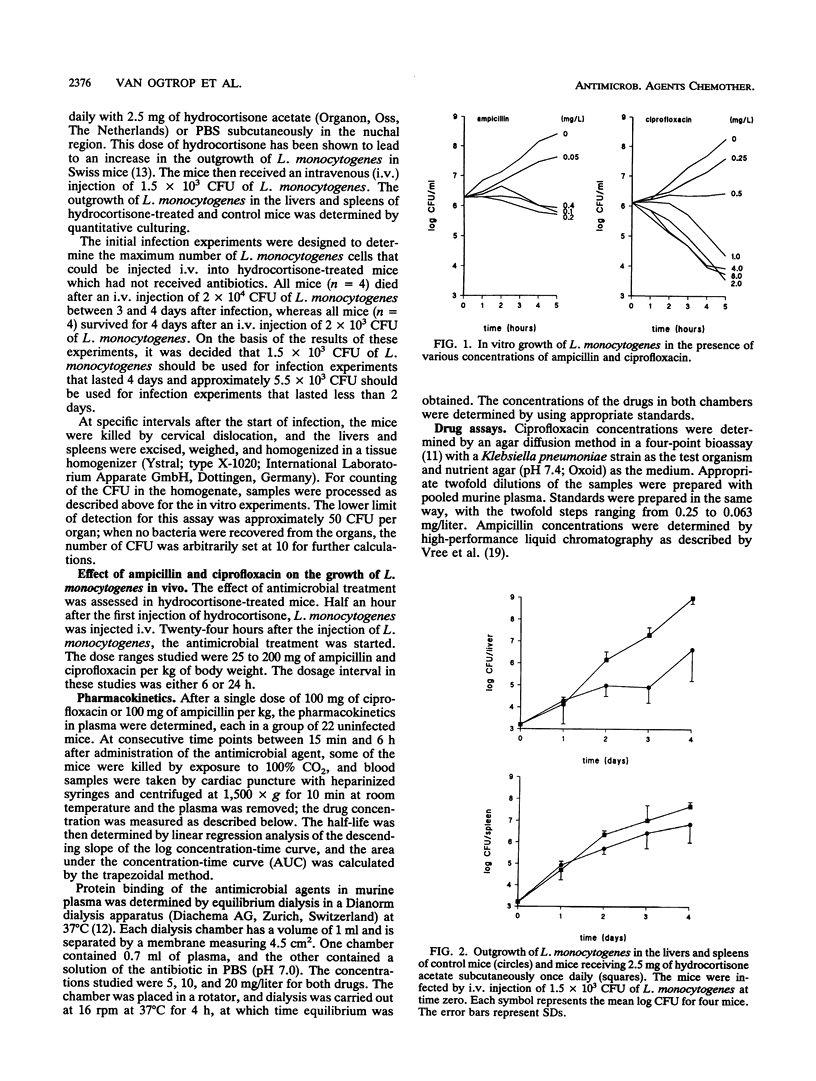Abstract
The efficacies of ciprofloxacin and ampicillin against Listeria monocytogenes in an immunosuppressed mouse model of listeriosis were compared. Immunosuppression was achieved by administration of 2.5 mg of hydrocortisone acetate daily. Both ciprofloxacin and ampicillin were effective in reducing the number of viable L. monocytogenes cells in the liver and spleen. After treatment with 100 mg of ampicillin per kg of body weight every 6 h for 3 days, virtually no L. monocytogenes could be recovered from the livers and spleens of the mice. In contrast, after treatment with 100 mg of ciprofloxacin per kg every 6 h for 3 days, a geometric mean of 5 x 10(4) CFU of L. monocytogenes was recovered from the spleens and 1 x 10(5) CFU was recovered from the livers of the mice. Results of the study show that the antibacterial efficacy of ampicillin is far superior to that of ciprofloxacin in our animal model of listeriosis.
Full text
PDF





Selected References
These references are in PubMed. This may not be the complete list of references from this article.
- Asensi V., Fierer J. Synergistic effect of human lysozyme plus ampicillin or beta-lysin on the killing of Listeria monocytogenes. J Infect Dis. 1991 Mar;163(3):574–578. doi: 10.1093/infdis/163.3.574. [DOI] [PubMed] [Google Scholar]
- Bakker-Woudenberg I. A., de Bos P., van Leeuwen W. B., Michel M. F. Efficacy of ampicillin therapy in experimental listeriosis in mice with impaired T-cell-mediated immune response. Antimicrob Agents Chemother. 1981 Jan;19(1):76–81. doi: 10.1128/aac.19.1.76. [DOI] [PMC free article] [PubMed] [Google Scholar]
- Campoli-Richards D. M., Monk J. P., Price A., Benfield P., Todd P. A., Ward A. Ciprofloxacin. A review of its antibacterial activity, pharmacokinetic properties and therapeutic use. Drugs. 1988 Apr;35(4):373–447. doi: 10.2165/00003495-198835040-00003. [DOI] [PubMed] [Google Scholar]
- Carlier M. B., Scorneaux B., Zenebergh A., Desnottes J. F., Tulkens P. M. Cellular uptake, localization and activity of fluoroquinolones in uninfected and infected macrophages. J Antimicrob Chemother. 1990 Oct;26 (Suppl B):27–39. doi: 10.1093/jac/26.suppl_b.27. [DOI] [PubMed] [Google Scholar]
- Dougherty T. F., White A. INFLUENCE OF ADRENAL CORTICAL SECRETION ON BLOOD ELEMENTS. Science. 1943 Oct 22;98(2547):367–369. doi: 10.1126/science.98.2547.367. [DOI] [PubMed] [Google Scholar]
- Easmon C. S., Crane J. P. Uptake of ciprofloxacin by human neutrophils. J Antimicrob Chemother. 1985 Jul;16(1):67–73. doi: 10.1093/jac/16.1.67. [DOI] [PubMed] [Google Scholar]
- Easmon C. S., Crane J. P. Uptake of ciprofloxacin by macrophages. J Clin Pathol. 1985 Apr;38(4):442–444. doi: 10.1136/jcp.38.4.442. [DOI] [PMC free article] [PubMed] [Google Scholar]
- KOWALSKI H. J., REYNOLDS W. E., RUTSTEIN D. D. Changes in white blood cell counts after administration of cortisone acetate to healthy ambulatory individuals. J Lab Clin Med. 1952 Dec;40(6):841–850. [PubMed] [Google Scholar]
- Mattie H., Goslings W. R., Noach E. L. Cloxacillin and nafcillin: serum binding and its relationship to antibacterial effect in mice. J Infect Dis. 1973 Aug;128(2):170–177. doi: 10.1093/infdis/128.2.170. [DOI] [PubMed] [Google Scholar]
- Mattie H., van der Voet G. B. The relative potency of amoxycillin and ampicillin in vitro and in vivo. Scand J Infect Dis. 1981;13(4):291–296. doi: 10.3109/inf.1981.13.issue-4.10. [DOI] [PubMed] [Google Scholar]
- North R. J. The action of cortisone acetate on cell-mediated immunity to infection. Suppression of host cell proliferation and alteration of cellular composition of infective foci. J Exp Med. 1971 Dec 1;134(6):1485–1500. doi: 10.1084/jem.134.6.1485. [DOI] [PMC free article] [PubMed] [Google Scholar]
- Portnoy D. A., Chakraborty T., Goebel W., Cossart P. Molecular determinants of Listeria monocytogenes pathogenesis. Infect Immun. 1992 Apr;60(4):1263–1267. doi: 10.1128/iai.60.4.1263-1267.1992. [DOI] [PMC free article] [PubMed] [Google Scholar]
- Schaffner A., Schaffner T. Glucocorticoid-induced impairment of macrophage antimicrobial activity: mechanisms and dependence on the state of activation. Rev Infect Dis. 1987 Sep-Oct;9 (Suppl 5):S620–S629. doi: 10.1093/clinids/9.supplement_5.s620. [DOI] [PubMed] [Google Scholar]
- Thompson J., van Furth R. The effect of glucocorticosteroids on the kinetics of mononuclear phagocytes. J Exp Med. 1970 Mar 1;131(3):429–442. doi: 10.1084/jem.131.3.429. [DOI] [PMC free article] [PubMed] [Google Scholar]
- Tuomanen E. Phenotypic tolerance: the search for beta-lactam antibiotics that kill nongrowing bacteria. Rev Infect Dis. 1986 Jul-Aug;8 (Suppl 3):S279–S291. doi: 10.1093/clinids/8.supplement_3.s279. [DOI] [PubMed] [Google Scholar]
- Vree T. B., Hekster Y. A., Baars A. M., Van der Kleijn E. Rapid determination of amoxycillin (clamoxyl) and ampicillin (penbritin) in body fluids of many by means of high-performance liquid chromatography. J Chromatogr. 1978 May 1;145(3):496–501. doi: 10.1016/s0378-4347(00)81384-5. [DOI] [PubMed] [Google Scholar]
- van den Broek P. J. Antimicrobial drugs, microorganisms, and phagocytes. Rev Infect Dis. 1989 Mar-Apr;11(2):213–245. doi: 10.1093/clinids/11.2.213. [DOI] [PubMed] [Google Scholar]


